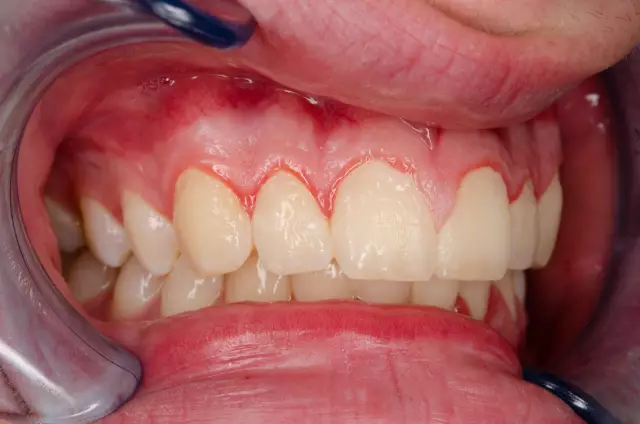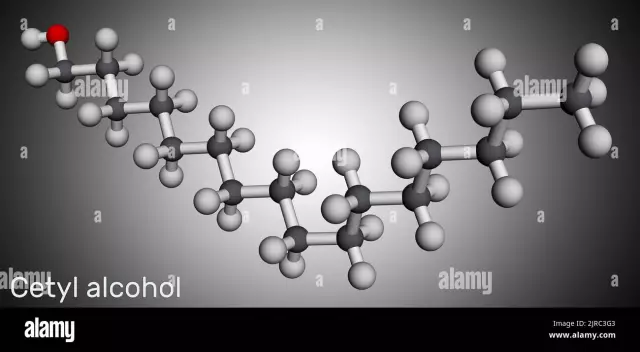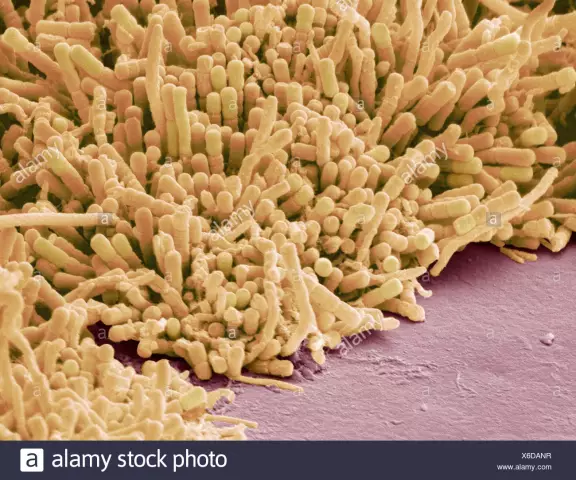- Author Rachel Wainwright [email protected].
- Public 2023-12-15 07:39.
- Last modified 2025-11-02 20:14.
Plaque on teeth: a cosmetic defect or a threat to health?
White teeth, "Hollywood" smile - the dream of many people. For a long time, it was believed that plaque and discoloration on teeth is the lot of those who do not eat properly, smoke and brush their teeth poorly. But the paradox is obvious: with all today's variety of toothpastes, toothbrushes and mouth rinses, the number of people embarrassed by plaque on their teeth is not decreasing. Moreover, plaque forms even in young children who definitely do not smoke or drink coffee. So what's the deal? And is plaque on the teeth dangerous for health?

Source: depositphotos.com
First of all, you need to say about the color of your teeth. The color of the enamel and the plaque on the teeth are completely different things. Tooth enamel is very hard; if it is well mineralized, it has a light shade. But the dentin under the enamel is softer and has a yellowish, grayish or even brown color. Accordingly, if the enamel is thin and transparent, dentin appears through it, and this changes the shade of the teeth. Perfectly white teeth are uncharacteristic for humans: usually the shade is slightly yellowish, especially in children - the enamel layer on milk teeth is rather thin.
With age, teeth inevitably turn yellow, and in addition, many external factors affect their shade: smoking, excessive consumption of tea and coffee, and taking certain medications.
But plaque on the teeth does not depend on the state of dentin and enamel and is an accumulation of microscopic remnants of food, drink and particles of the epithelium of the oral mucosa. An ideal environment for bacteria to grow: warm, humid and nutritious!
Types of plaque
Almost all people have white or yellowish plaque - between the teeth, on the back molars, above the gum. That is, where cleaning is difficult. It can be easily removed by your dentist, and if you clean your teeth properly using dental floss and mouthwash, such plaque will appear less frequently.
It is much more difficult to get rid of yellow or brownish plaque. It is this plaque that gradually occurs among heavy smokers, lovers of strong tea and coffee. There are often brown deposits on the teeth of people with impaired metabolism, when iron is released through saliva, which forms brown salts. Another possible cause is the presence of copper fillings or dentures in the mouth. Getting rid of this plaque requires regular dental visits, professional cleaning, and sometimes teeth whitening. Of course, in case of metabolic disorders, it is necessary to simultaneously eliminate the underlying disease, otherwise the result of cleaning will not last long.
Gray plaque is the result of hypoplasia of the tooth enamel, which is especially common in children. In this case, medical treatment is required to restore the enamel. It is impossible to remove gray plaque on your own.
Greenish plaque looks very strange and is found mainly in young children or adolescents. The reason is special microorganisms - fungi, which secrete the coloring pigment chlorophyll. Elimination of such plaque should only be carried out by a dentist.
Finally, black bloom also occurs due to a special type of mushroom. It testifies primarily to severe malfunctions in the body - for example, diseases of the biliary tract or parasitic diseases. Children and adolescents have the so-called Priestley bacterial plaque, the exact cause of which has not yet been clarified. Priestley's plaque does not destroy teeth and goes away with age, but the appearance of the teeth, of course, leaves much to be desired.
Hard plaque
All the types of plaque that we talked about are soft. However, soft plaque, not removed in time, mineralizes and hardens, turning into tartar. Most often it is located on the inner surface of the teeth. It is impossible to clean or wash it off on your own - it has a very strong adhesion to the tooth surface. However, the structure of the stone is porous, so bacteria that produce lactic acid live and actively multiply in it. And she, in turn, damages the enamel of the teeth, causing caries.
So hard plaque isn't just a cosmetic flaw. It must be removed by the dentist, otherwise the teeth will begin to decay.

Source: depositphotos.com
Prevention of plaque on teeth
If the formation of plaque is associated with various diseases of internal organs, then, of course, the problem must be solved in a comprehensive manner. However, in any case, you should adhere to simple rules that will help prevent the onset and spread of soft plaque:
- brush your teeth at least twice a day;
- thoroughly clean hard-to-reach places in the mouth - for example, the inner surface of the teeth;
- change toothbrushes regularly as they wear out;
- be sure to use dental floss to remove food debris between your teeth;
- use mouth rinses;
- eating solid food - it helps self-cleaning teeth.
In the case of plaque formation, it is better not to try to remove it with improvised methods, but contact a dentist as soon as possible. Folk remedies such as crushed activated carbon, soda, hydrogen peroxide, lemon juice are not safe, they can easily damage the enamel - especially with frequent use. And it is impossible to remove a hard plaque with them. Therefore, once or twice a year you need to visit the dentist for professional teeth cleaning and dental calculus removal. This procedure will prevent many dental problems.
YouTube video related to the article:

Maria Kulkes Medical journalist About the author
Education: First Moscow State Medical University named after I. M. Sechenov, specialty "General Medicine".
Found a mistake in the text? Select it and press Ctrl + Enter.






